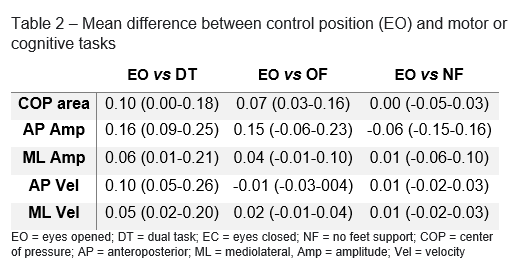Category: Parkinson’s Disease: Clinical Trials
Objective: To analyze trunk balance control of individuals with Parkinson disease (PD) in seated position and compare the control position with motor and cognitive tasks.
Background: Trunk balance control is an important part of postural control and fall risk decrease. People with PD experience difficulties in maintenance of trunk balance control, especially when it is associated with different motor or cognitive tasks.
Method: Transversal study, composed by 15 individuals with PD (11 male, 69,9±7,0 years) from mild to moderate stages, with no cognitive impairments. It was used the prototype of an unstable chair positioned upper to a force platform, and participants were submitted to evaluation in 5 conditions: seated with eyes opened (EO) (control position), eyes closed (EC), dual task (DT) with Stroop test and with no feet support (NF). We considered the parameter COP area, anteroposterior (AP) and mediolateral (ML) amplitude and AP and ML velocity in each condition. They were control group of themselves. For statistical analysis, we performed Wilcoxon test to compare EO position with EC, DT and NF conditions. We also calculated mean difference and compare conditions by Friedman test.
Results: There was increase in all parameters of DT when compared to EO condition [ΔCOP: 0.10 (0.00-0.18); p=0.02, ΔAP amplitude: 0.16 (0.09-0.25); p<0.01, ΔML amplitude: 0.06 (0.01-0.21); p=0.02, ΔAP velocity: 0.10 (0.05-0.26); p<0.01 and ΔML velocity: 0.05 (0.02-0.20); p=0.01]. EC also presented increase in comparison to EO [ΔCOP area [0.07 (0.03-0.16); p<0.01, and ΔAP amplitude 0.15 (-0.06-0.23), p=0.04] and there were no statistical differences between OA and NF or between tasks (DT, EC and NF) (Tables 1 and 2).
Conclusion: This was a preliminary study to understand trunk balance control standards (in the sitting position) in individuals with PD. We perceived higher difficulty in maintenance of stability under DT situation than in EC. Moreover, removing the feet support base did not affect their trunk control. More studies are necessary to determine the trunk balance control parameters in individuals with PD, as well as to compare the stability standards with healthy individuals and in different stages of PD, in addition to establishing cutoffs point to static and dynamic parameters for this population.
To cite this abstract in AMA style:
H. Araújo, A. Miri, R. Volpe, M. Oliveira, R. Silva Jr, S. Smaili. Trunk postural control in seated position on a prototype of unstable chair and the interference of cognitive and motor tasks in individuals with Parkinson disease [abstract]. Mov Disord. 2021; 36 (suppl 1). https://www.mdsabstracts.org/abstract/trunk-postural-control-in-seated-position-on-a-prototype-of-unstable-chair-and-the-interference-of-cognitive-and-motor-tasks-in-individuals-with-parkinson-disease/. Accessed April 3, 2025.« Back to MDS Virtual Congress 2021
MDS Abstracts - https://www.mdsabstracts.org/abstract/trunk-postural-control-in-seated-position-on-a-prototype-of-unstable-chair-and-the-interference-of-cognitive-and-motor-tasks-in-individuals-with-parkinson-disease/


